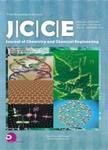3D-QSAR and action mechanism of potential dual inhibitors towards AP-1 and NF-κB
3D-QSAR and action mechanism of potential dual inhibitors towards AP-1 and NF-κB作者机构:School of Chemistry and Chemical Engineering Sun Yat-Sen University Guangzhou 510275 China
出 版 物:《Journal of Chemistry and Chemical Engineering》 (化学与化工(英文版))
年 卷 期:2009年第3卷第1期
页 面:1-12页
学科分类:090403[农学-农药学(可授农学、理学学位)] 083001[工学-环境科学] 0830[工学-环境科学与工程(可授工学、理学、农学学位)] 08[工学] 09[农学] 0904[农学-植物保护]
基 金:Acknowledgments: The authors are pleased to thank the financial supports of the National Natural Science Foundation of China (Nos.: 20673148 and 90608012). We heartily thank the Molecular Discovery Ltd. for giving us the Dock 6.0 program as a freewarc. The authors are also pleased to thank the College of Life Sciences Sun Yat-Sen University for the Sybyl 6.9 computation environment support
主 题:pyrimidine derivative 3D-QSAR docking analysis activator protein-1 nuclear factor kappa B
摘 要:Three-dimensional quantitative structure-activity relationship (3D-QSAR) and docking studies of a series of novel dioxopyrrolinyl-amino-pyrimidine derivatives, which are potential dual inhibitors mediating a transcriptional activation towards protein-1 (AP-1) and nuclear factor kappa B (NF-κB), have been carried out. The QS, AR models established by comparative molecular field analysis (CoMFA) and comparative molecular similarity index analysis (CoMSIA) show a good predictive ability with cross-validated coefficients q2 of 0.644 and 0.636, respectively. The docking result shows that there are quite lower average values of the flexible and rigid energy scores on the selected binding sites, meanwhile, it further shows that the binding sites just fall on the joint regions between AP-1 (and NF-κB) and DNA. The reason that these analogues have inhibition function towards AP-I and NF-κB is that their existence on these joint regions can effectively prevent free AP-I and NF-κB from binding to DNA. These results can offer a valuable theoretical reference to the pharmaceutical molecular design as well as the action mechanism analysis.



